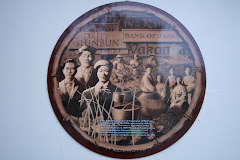 Tokyo Creator's Market, a new art exhibit at Japantown's New People, opened Saturday, and the debut was accompanied by Bazaar Bizarre vendor kiosks stationed throughout the three-story building.
Tokyo Creator's Market, a new art exhibit at Japantown's New People, opened Saturday, and the debut was accompanied by Bazaar Bizarre vendor kiosks stationed throughout the three-story building.Visitors perused the art fair tables, such as Skinni Wini's Lolita decor and Stephanie Lee's food themed accessories (right), on their way to the art exhibit in the third-floor Superfrog Gallery.
Mika Anami, the general manger of the Superfrog Gallery, called the setup a vertical art village that really added a local tie-in to the event and brought more visitors.
"Over 1,000 people reserved spots at the Friday night special viewing and about 400 to 500 showed up," Anami said while sitting behind her desk in the spacious gallery.
Artisans from Bazaar Bizarre, a network of handmade arts and crafts dealers and do it yourself workshops, were enjoying the event.


"I'm right next to my dream store," said Skinni Wini about the Lolita fashion boutique Baby, the Stars Shine Bright.Wini designs and sells products similar to what Baby, the Stars Shine Bright offers.
"I like when you dress up and you become a different person," said Wini, who was dressed in one of her Lolita outfits. "You're kinder, cute, and you don't harm people because the Lolita style is all about cuteness."
After browsing through the purchasable arts and crafts on the first two floors, visitors moved on to the Tokyo Creators Market, where items were not for sale.
Artwork was displayed from seven different artists:
Artwork was displayed from seven different artists:
-Tomomi Kazumoto is a screen printer and attempts to remind viewers of childhood with her dime-store darkness and playfulness. (Right).
-Kim Songhe is known for sculptures built from natural materials and reusable wastes. She creates original chandeliers and designs shop window displays.
-Mikito Ozeki presents the BODY series, which is intended to stimulate the wavering of human values by showing the ambiguous robot figures with clear lines and forms of a paper cutout. (Below).

-Kim Songhe is known for sculptures built from natural materials and reusable wastes. She creates original chandeliers and designs shop window displays.
-Mikito Ozeki presents the BODY series, which is intended to stimulate the wavering of human values by showing the ambiguous robot figures with clear lines and forms of a paper cutout. (Below).

-Noritake blends simple lines and multiple motifs that seemingly have nothing in common. Drawing from old photos, magazines and picture books, he adds in new elements and leaves it to the viewers to make their own discovery.
-The On Za Line design team attempts to celebrate passion, atmosphere and time with its handmade products.
-Yuichi Yokoyama, famous for his picture books, presents comic drawings usually depicting character movement or action.
-The On Za Line design team attempts to celebrate passion, atmosphere and time with its handmade products.
-Yuichi Yokoyama, famous for his picture books, presents comic drawings usually depicting character movement or action.
“Pop culture serves as a theme with limitless possibilities for artistic expression and we’re very excited to present one of the most unique art shows to come to San Francisco this year,” says Seiji Horibuchi, the Founder of New People. “Each of these
artists is distinctive in their own expression, originality and style. We invite everyone to use Japanese pop culture as inspiration in their own lives."





